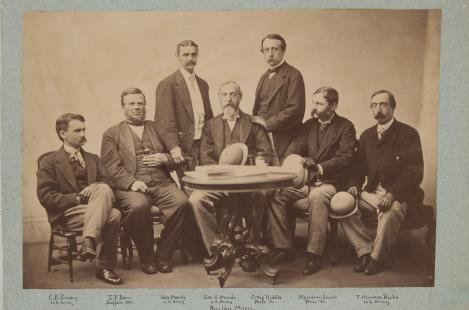The Society Prepares for the Twenty-First Century
The Historical Society of Pennsylvania is a treasure chest. The key to that treasure chest will be our clarity of purpose in addressing its key priorities.” -- Susan Stitt, September 1990.(1)
During the mid-1990s, the Historical Society of Pennsylvania (HSP) faced growing financial challenges as they prepared their nineteenth-century institution for the twenty-first century.
According to Howard Lewis, HSP’s board chair during the mid-1990s, the society traditionally appeared as “a place for the Society’s members to gather for tea after the orchestra and as an attic for them to bequeath family heirlooms.”(2) HSP hired Susan Stitt, “a professional manager, not an academic,” as the new president and CEO to provide better management and apply changes. Within two years, Stitt offered three options for HSP to better manage their finances and develop a more robust mission.
- “Live within our means”--Preserve the collections but raise funds before implementing programing.
- “Get Smaller to get better”--Keep library and archival material but deaccession art and artifacts.
- “Big Idea”--Keep library and archival materials but donate art and artifacts to a (not yet existing) Philadelphia history center.
Once HSP’s board members realized that their precious art and artifacts could be deaccessioned, they showed great reluctance to Stitt’s proposals. These attitudes highlighted the difference between board members who considered HSP a social club and the staff who understood their role as caretakers for the collections and artifacts. The difference of opinions prevented HSP from fully recognizing or executing an effective mission.
Without knowing the complete history of the Civil War Museum of Philadelphia, I wonder what conversations their institution had during this same period. The Civil War Museum and HSP shared similar challenges including maintenance of an historic building, lack of physical space for expansion, an array of archival documents and artifacts that complicated their mission as either a research library or museum, and a conservative board unwilling to implement changes. (3)

HSP eventually decided on the second option and deaccessioned most of their collection. Although most of the collection was donated to the Atwater Kent Museum, it remained in Philadelphia. The Civil War Museum, on the other hand, never adapted and had its collection of artifacts relocated to Gettysburg and its paper records rehoused at the Union League. Perhaps the new locations better serve the greater cultural sector, but regardless, the Civil War Museum refused to adapt and eventually folded. HSP implemented changes and kept their collections in Philadelphia. Although HSP still faces challenges, the institution still exists unlike the Civil War Museum, and its curious to consider the different administrative approaches of two similar organizations.
Resources:
- Quoted from Stephen A. Greyser and Stephanie Woerner, “The Historical Society of Pennsylvania,” (Harvard Business School case study), November 20, 1996, revised February 5, 1997, pg. 1
- Ibid, 1.
- Without knowing more about the Civil War Museum of Philadelphia this is only speculative. Since the museum served MOLLUS, I imagine many members were unwilling to part ways with their collection and “get smaller to get better.”
100% of the SBD rewards from this #explore1918 post will support the Philadelphia History Initiative @phillyhistory. This crypto-experiment conducted by graduate courses at Temple University's Center for Public History and MLA Program, is exploring history and empowering education. Click here to learn more.

An interesting comparison, HSP and the Civil War Museum. I think the former had the advantage of being perceived as an essential player in the city's cultural ecosystem and the latter did not. Exploring exactly what that means would be an interesting discussion. How does an org become valued by its community to a point where it would not be allowed to fail?